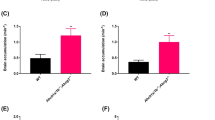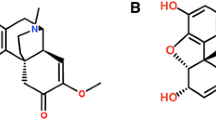Abstract
Rationale
Transport across the BBB is a determinant of the rate and extent of drug distribution in the brain. Heroin exerts its effects through its principal metabolites 6-monoacetyl-morphine (6-MAM) and morphine. Morphine is a known substrate of P-glycoprotein (P-gp) at the blood-brain-barrier (BBB) however, little is known about the interaction of heroin and 6-MAM with P-gp.
Objective
The objective of this paper is to study the role of the P-gp-mediated efflux at the BBB in the behavioral and molecular effects of heroin and morphine.
Methods
The transport rates of heroin and its main metabolites, at the BBB, were measured in mice by in situ brain perfusion. We then examined the effect of inhibition of P-gp on the acute nociception, locomotor activity, and gene expression modulations induced by heroin and morphine. The effect of P-gp inhibition during the acquisition of morphine-induced place preference was also studied.
Results
Inhibition of P-gp significantly increased the uptake of morphine but not that of heroin nor 6-MAM. Inhibition of P-gp significantly increased morphine-induced acute analgesia and locomotor activity but did not affect the behavioral effects of heroin; in addition, acute transcriptional responses to morphine were selectively modulated in the nucleus accumbens. Increasing morphine uptake by the brain significantly increased its reinforcing properties in the place preference paradigm.
Conclusions
The present study demonstrated that acute inhibition of P-gp not only modulates morphine-induced behavioral effects but also its transcriptional effects and reinforcing properties. This suggests that, in the case of morphine, transport across the BBB is critical for the development of dependence.






Similar content being viewed by others
Abbreviations
- P-gp:
-
P-glycoprotein
- 6-MAM:
-
6-Monoacetyl-morphine
- Nac:
-
Nucleus accumbens
- IEG:
-
Immediate early genes
References
Abbott NJ, Patabendige AA, Dolman DE, Yusof SR, Begley DJ (2010) Structure and function of the blood-brain barrier. Neurobiol Dis 37:13–25
Abreu ME, Bigelow GE, Fleisher L, Walsh SL (2001) Effect of intravenous injection speed on responses to cocaine and hydromorphone in humans. Psychopharmacology (Berlin) 154:76–84
Achira M, Suzuki H, Ito K, Sugiyama Y (1999) Comparative studies to determine the selective inhibitors for P-glycoprotein and cytochrome P4503A4. AAPS Pharm Sci 1:E18
Andersen JM, Ripel A, Boix F, Normann PT, Morland J (2009) Increased locomotor activity induced by heroin in mice: pharmacokinetic demonstration of heroin acting as a prodrug for the mediator 6-monoacetylmorphine in vivo. J Pharmacol Exp Ther 331:153–161
Bardo MT, Rowlett JK, Harris MJ (1995) Conditioned place preference using opiate and stimulant drugs: a meta-analysis. Neurosci Biobehav Rev 19:39–51
Barrio G, De La Fuente L, Lew C, Royuela L, Bravo MJ, Torrens M (2001) Differences in severity of heroin dependence by route of administration: the importance of length of heroin use. Drug Alcohol Depend 63:169–177
Belkai E, Scherrmann JM, Noble F, Marie-Claire C (2009) Modulation of MDMA-induced behavioral and transcriptional effects by the delta opioid antagonist naltrindole in mice. Addict Biol 14:245–252
Boix F, Andersen JM, Morland J (2013) Pharmacokinetic modeling of subcutaneous heroin and its metabolites in blood and brain of mice. Addict Biol 18:1–7
Cattelotte J, Andre P, Ouellet M, Bourasset F, Scherrmann JM, Cisternino S (2008) In situ mouse carotid perfusion model: glucose and cholesterol transport in the eye and brain. J Cereb Blood Flow Metab Off J Int Soc Cereb Blood Flow Metab 28:1449–1459
Chardin P (2006) Function and regulation of Rnd proteins. Nat Rev Mol Cell Biol 7:54–62
Cisternino S, Rousselle C, Dagenais C, Scherrmann JM (2001) Screening of multidrug-resistance sensitive drugs by in situ brain perfusion in P-glycoprotein-deficient mice. Pharm Res 18:183–190
Cisternino S, Rousselle C, Debray M, Scherrmann JM (2004) In situ transport of vinblastine and selected P-glycoprotein substrates: implications for drug-drug interactions at the mouse blood-brain barrier. Pharm Res 21:1382–1389
Comer SD, Collins ED, MacArthur RB, Fischman MW (1999) Comparison of intravenous and intranasal heroin self-administration by morphine-maintained humans. Psychopharmacology (Berlin) 143:327–338
Dagenais C, Rousselle C, Pollack GM, Scherrmann JM (2000) Development of an in situ mouse brain perfusion model and its application to mdr1a P-glycoprotein-deficient mice. J Cereb Blood Flow Metab Off J Int Soc Cereb Blood Flow Metab 20:381–386
Dagenais C, Zong J, Ducharme J, Pollack GM (2001) Effect of mdr1a P-glycoprotein gene disruption, gender, and substrate concentration on brain uptake of selected compounds. Pharm Res 18:957–963
Dagenais C, Graff CL, Pollack GM (2004) Variable modulation of opioid brain uptake by P-glycoprotein in mice. Biochem Pharmacol 67:269–276
Decleves X, Jacob A, Yousif S, Shawahna R, Potin S, Scherrmann JM (2011) Interplay of drug metabolizing CYP450 enzymes and ABC transporters in the blood-brain barrier. Curr Drug Metab 12:732–741
Di Ciano P, Robbins TW, Everitt BJ (2008) Differential effects of nucleus accumbens core, shell, or dorsal striatal inactivations on the persistence, reacquisition, or reinstatement of responding for a drug-paired conditioned reinforcer. Neuropsychopharmacology 33:1413–1425
Eddy NB, Leimbach D (1953) Synthetic analgesics. II. Dithienylbutenyl- and dithienylbutylamines. J Pharmacol Exp Ther 107:385–393
Galtress T, Kirkpatrick K (2010) The role of the nucleus accumbens core in impulsive choice, timing, and reward processing. Behav Neurosci 124:26–43
Hand TH, Stinus L, Le Moal M (1989) Differential mechanisms in the acquisition and expression of heroin-induced place preference. Psychopharmacology (Berlin) 98:61–67
Hyman SE, Malenka RC (2001) Addiction and the brain: the neurobiology of compulsion and its persistence. Nat Rev Neurosci 2:695–703
King M, Su W, Chang A, Zuckerman A, Pasternak GW (2001) Transport of opioids from the brain to the periphery by P-glycoprotein: peripheral actions of central drugs. Nat Neurosci 4:268–274
Kitanaka N, Sora I, Kinsey S, Zeng Z, Uhl GR (1998) No heroin or morphine 6beta-glucuronide analgesia in mu-opioid receptor knockout mice. Eur J Pharmacol 355:R1–R3
Korostynski M, Kaminska-Chowaniec D, Piechota M, Przewlocki R (2006) Gene expression profiling in the striatum of inbred mouse strains with distinct opioid-related phenotypes. BMC Genomics 7:146
Kusunoki N, Takara K, Tanigawara Y, Yamauchi A, Ueda K, Komada F, Ku Y, Kuroda Y, Saitoh Y, Okumura K (1998) Inhibitory effects of a cyclosporin derivative, SDZ PSC 833, on transport of doxorubicin and vinblastine via human P-glycoprotein. Jpn J Cancer Res: Gann 89:1220–1228
Letrent SP, Pollack GM, Brouwer KR, Brouwer KL (1999) Effects of a potent and specific P-glycoprotein inhibitor on the blood-brain barrier distribution and antinociceptive effect of morphine in the rat. Drug Metab Dispos Biol Fate Chem 27:827–834
Lv XF, Xu Y, Han JS, Cui CL (2011) Expression of activity-regulated cytoskeleton-associated protein (Arc/Arg3.1) in the nucleus accumbens is critical for the acquisition, expression and reinstatement of morphine-induced conditioned place preference. Behav Brain Res 223:182–191
Marie-Claire C, Salzmann J, David A, Courtin C, Canestrelli C, Noble F (2007) Rnd family genes are differentially regulated by 3,4-methylenedioxymethamphetamine and cocaine acute treatment in mice brain. Brain Res 1134:12–17
Marsch LA, Bickel WK, Badger GJ, Rathmell JP, Swedberg MD, Jonzon B, Norsten-Hoog C (2001) Effects of infusion rate of intravenously administered morphine on physiological, psychomotor, and self-reported measures in humans. J Pharmacol Exp Ther 299:1056–65
Martin WR, Fraser HF (1961) A comparative study of physiological and subjective effects of heroin and morphine administered intravenously in postaddicts. J Pharmacol Exp Ther 133:388–399
Nestler EJ (2001) Molecular neurobiology of addiction. Am J Addict 10:201–217
Oldendorf WH (1992) Some relationships between addiction and drug delivery to the brain. NIDA Res Monogr 120:13–25
Oldendorf WH, Hyman S, Braun L, Oldendorf SZ (1972) blood-brain barrier: penetration of morphine, codeine, heroin, and methadone after carotid injection. Science 178:984–986
Owens DM, Keyse SM (2007) Differential regulation of MAP kinase signalling by dual-specificity protein phosphatases. Oncogene 26:3203–3213
Piechota M, Korostynski M, Solecki W, Gieryk A, Slezak M, Bilecki W, Ziolkowska B, Kostrzewa E, Cymerman I, Swiech L, Jaworski J, Przewlocki R (2010) The dissection of transcriptional modules regulated by various drugs of abuse in the mouse striatum. Genome Biol 11:R48
Roberts DJ, Goralski KB (2008) A critical overview of the influence of inflammation and infection on P-glycoprotein expression and activity in the brain. Exp Opin Drug Metab Toxicol 4:1245–1264
Robinson TE, Berridge KC (2000) The psychology and neurobiology of addiction: an incentive-sensitization view. Addiction 95(Suppl 2):S91–S117
Robinson TE, Kolb B (1999) Morphine alters the structure of neurons in the nucleus accumbens and neocortex of rats. Synapse 33:160–162
Samaha A-N, Mallet N, Ferguson SM, Gonon F, Robinson TE (2004) The rate of cocaine administration alters gene regulation and behavioral plasticity: implications for addiction. J Neurosci 24:6362–6370
Samaha AN, Yau WY, Yang P, Robinson TE (2005) Rapid delivery of nicotine promotes behavioral sensitization and alters its neurobiological impact. Biol Psychiatry 57:351–360
Scherrmann JM (2005) Expression and function of multidrug resistance transporters at the blood-brain barriers. Exp Opin Drug Metab Toxicol 1:233–246
Schinkel AH, Wagenaar E, van Deemter L, Mol CA, Borst P (1995) Absence of the mdr1a P-Glycoprotein in mice affects tissue distribution and pharmacokinetics of dexamethasone, digoxin, and cyclosporin A. J Clin Investig 96:1698–1705
Selley DE, Cao CC, Sexton T, Schwegel JA, Martin TJ, Childers SR (2001) mu Opioid receptor-mediated G-protein activation by heroin metabolites: evidence for greater efficacy of 6-monoacetylmorphine compared with morphine. Biochem Pharmacol 62:447–455
Smith GM, Beecher HK (1962) Subjective effects of heroin and morphine in normal subjects. J Pharmacol Exp Ther 136:47–52
Smolka M, Schmidt LG (1999) The influence of heroin dose and route of administration on the severity of the opiate withdrawal syndrome. Addiction 94:1191–1198
Tallarida RJ, Murray RB (1986) Manual of pharmacological calculation, 2nd edn. Springer, New York
Thompson SJ, Koszdin K, Bernards CM (2000) Opiate-induced analgesia is increased and prolonged in mice lacking P-glycoprotein. Anesthesiology 92:1392–1399
Tolliver BK, Sganga MW, Sharp FR (2000) Suppression of c-fos induction in the nucleus accumbens prevents acquisition but not expression of morphine-conditioned place preference. Eur J Neurosci 12:3399–3406
Tournier N, Decleves X, Saubamea B, Scherrmann JM, Cisternino S (2011) Opioid transport by ATP-binding cassette transporters at the blood-brain barrier: implications for neuropsychopharmacology. Curr Pharm Des 17:2829–2842
Valjent E, Pages C, Herve D, Girault J-A, Caboche J (2004) Addictive and non-addictive drugs induce distinct and specific patterns of ERK activation in mouse brain. Eur J Neurosci 19:1826–1836
Wang QL, Liu ZM (2012) Characteristics of psychopathology and the relationship between routes of drug administration and psychiatric symptoms in heroin addicts. Subst Abus Off Publ Assoc Med Educ Res Subst Abus 33:130–137
Watanabe T, Tsuge H, Oh-Hara T, Naito M, Tsuruo T (1995) Comparative study on reversal efficacy of SDZ PSC 833, cyclosporin A and verapamil on multidrug resistance in vitro and in vivo. Acta Oncol 34:235–241
Watson B, Meng F, Akil H (1996) A chimeric analysis of the opioid receptor domains critical for the binding selectivity of mu opioid ligands. Neurobiol Dis 3:87–96
Wickens JR, Budd CS, Hyland BI, Arbuthnott GW (2007) Striatal contributions to reward and decision making: making sense of regional variations in a reiterated processing matrix. Ann N Y Acad Sci 1104:192–212
Xie R, Hammarlund-Udenaes M, de Boer AG, de Lange EC (1999) The role of P-glycoprotein in blood-brain barrier transport of morphine: transcortical microdialysis studies in mdr1a (−/−) and mdr1a (+/+) mice. Br J Pharmacol 128:563–568
Zong J, Pollack GM (2000) Morphine antinociception is enhanced in mdr1a gene-deficient mice. Pharm Res 17:749–753
Acknowledgments
The authors thank Didier Fauconnier for technical assistance and the animal facility of the Institut Medicament-Toxicologie-Chimie-Environnement for providing resources. This work was supported by Centre National de la Recherche Scientifique (CNRS) UMR8206 and Institut National de la Santé et de la Recherche Médicale (INSERM) U705 and Université Paris Descartes. The authors have no financial interest to disclose.
Author information
Authors and Affiliations
Corresponding author
Rights and permissions
About this article
Cite this article
Seleman, M., Chapy, H., Cisternino, S. et al. Impact of P-glycoprotein at the blood-brain barrier on the uptake of heroin and its main metabolites: behavioral effects and consequences on the transcriptional responses and reinforcing properties. Psychopharmacology 231, 3139–3149 (2014). https://doi.org/10.1007/s00213-014-3490-9
Received:
Accepted:
Published:
Issue Date:
DOI: https://doi.org/10.1007/s00213-014-3490-9




